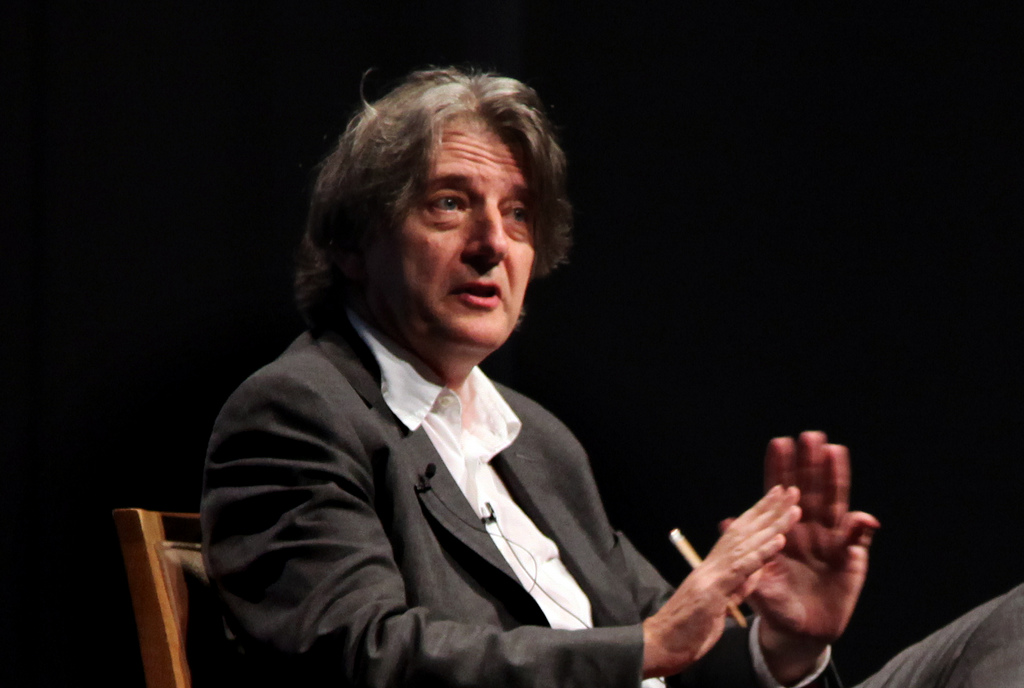
Why is it that a piece of decorative art sells for 10 times less than a painting from the same period, and of the same quality and intensity as the artwork?
“One of them,” Deyan Sudjic said to the packed crowd at the Getty Museum, “is cursed with the burden of utility, and the other is not.”
Sudjic, director of the Design Museum London and author of The Language of Things: Understanding the World of Desirable Objects, went on to explain that, as the sociologist Thorstein Veblen said, societies tend to elevate the useless over the useful. But now the useful, Sudjic showed, has transformed. Design seems increasingly like art, and vice versa, and objects carry more significance and symbolism even as we replace them more often, own more of them, and use them less.
Design as art, art as design
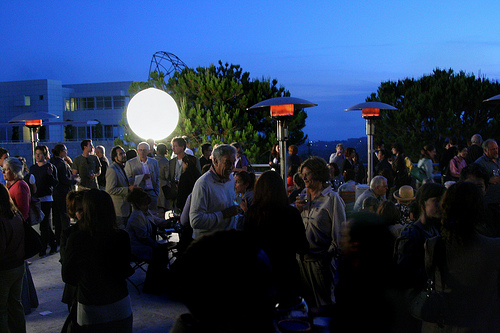 Objects have always conveyed meaning, even when they were considered purely utilitarian. Wearing white clothes reflected a certain class status for those who did not have to work or worry about cleanliness. Complicated and towering shoes implied a life of leisure. But art and design were kept at a distance, Sudjic noted, and design was called “commercial art” to distinguish it. A deep tension remains, even as contemporary art itself seems more like design. Sudjic cited Jeff Koons as one artist who has something like a “design process,” in which assistants help him transform ideas to blueprints that are then “shipped off to a factory somewhere in Eastern Germany where useful objects are manufactured.”
Objects have always conveyed meaning, even when they were considered purely utilitarian. Wearing white clothes reflected a certain class status for those who did not have to work or worry about cleanliness. Complicated and towering shoes implied a life of leisure. But art and design were kept at a distance, Sudjic noted, and design was called “commercial art” to distinguish it. A deep tension remains, even as contemporary art itself seems more like design. Sudjic cited Jeff Koons as one artist who has something like a “design process,” in which assistants help him transform ideas to blueprints that are then “shipped off to a factory somewhere in Eastern Germany where useful objects are manufactured.”
Similarly, Sudjic said, “one can also see the way contemporary design is now moving toward uselessness,” with things like limited-edition furniture, and highly expensive auctioned items meant not to be used for their ostensible purpose. Objects once had to convey sturdiness and singular purpose. But now, “we take performance for granted,” Sudjic said during Q&A. “In the 50s and 60s, things blew up…. Now, there is no need for the reassurance of seriousness.”
Official objects
Some seemingly wholly utilitarian objects carry deep symbolism, Sudjic explained, showing a 20-pound note to the audience. “How extraordinary a task is it to be asked to transform a rectangle of worthless paper into something that is worth 20 pounds?” he asked, before flashing up “a worthless piece of American paper,” or a 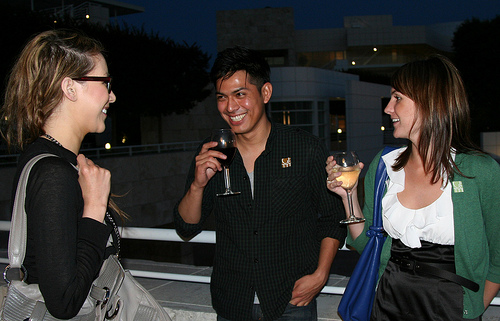 $100 bill. Money designs adopt particular artistic styles – like the 19th-century engravings used to depict the American founders – and particular typefaces (reminiscent, in the case of the dollar, of cigar boxes, Sudjic joked). And imagery matters too – the Euro shows doors, windows, and bridges in an attempt to convey connectedness.
$100 bill. Money designs adopt particular artistic styles – like the 19th-century engravings used to depict the American founders – and particular typefaces (reminiscent, in the case of the dollar, of cigar boxes, Sudjic joked). And imagery matters too – the Euro shows doors, windows, and bridges in an attempt to convey connectedness.
Camaflouge, like money, serves the same purpose everywhere but also differs everywhere, Sudjic showed. “What’s going on here is not really about concealment,” Sudjic said, showing the audience various countries’ camouflage patterns, all distinct. “It’s about using design and the rhetoric of function to create an aura of strength, of uniformity about the military.”
Clothes and cars
Even beyond camouflage, fashion can create a sense of national purpose. Japan’s imperial rulers and Turkey’s Kemal Ataturk began wearing Western-style clothes to convey a change of direction for their countries. “Fashion we are told is an essentially frivolous act, but I’ve never bought that,” Sudjic said. “I’m always right behind the speech from ‘The Devil Wears Prada,’ in which the editor tells us how important fashion is.” The industry not only creates jobs, but advances in looms and textile manufacturing drove the Industrial Revolution, Sudjic noted. And fashion is a “hugely important cultural form.” Fashion houses construct elaborate headquarters and stores, and the fashion show somewhat resembles the 19th century opera, Sudjic said. It is a place to see and be seen, and at 20 minutes long, “much easier to sit through.”
Consumer objects can also convey a national identity, particularly the car, whether the VW Beetle, the Model T, or the Citroën 2CV. More recent models still convey identity – like the latest Bentley, with its ghostly, sleek luxury, which seems British even if it’s owned by a German manufacturer and employs a cosmopolitan design team. “Clearly a great deal of research went into producing the Englishness,” Sudjic joked. Newer models also demonstrate a shift in car design norms – from “inventing a car as if none had ever existed,” Sudjic said, to “something rather close to rearing sheep, when it’s very important that you show bloodlines.” And though the car has come to be “a set of signals, a giant toy for adults, pandering to our self-image,” there is still something magical about the creation of luxury. Luxury, Sudjic said, is “a rather curious conjuring trick. Alchemical.”
Tech toys and old-fashioned gizmos
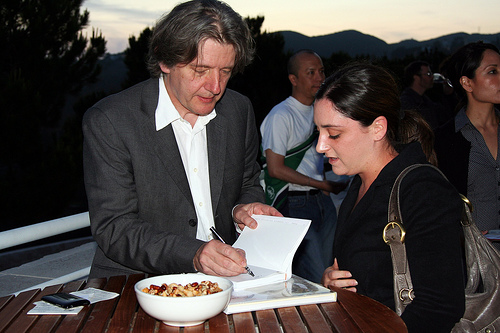 Sudjic discussed too the more common, less expensive objects we use daily: the computer, the telephone, the camera, and more. Apple’s use of color and design to transform its laptops, Sudjic noted, followed the example of Olivetti, the typewriter manufacturer. In 1972 Olivetti transformed a “serious business object” that signified primarily “being chained to a desk” and turned it into a red-and-orange, curvy consumer toy. Of course, Apple’s first foray into curvy colorful laptop was quickly replaced, Sudjic noted, by a stark black number which Sudjic bought and found captured “the language of business,” of showing that “you can’t be seduced by pastel colors, which of course is the strongest and most seductive lure of them all.”
Sudjic discussed too the more common, less expensive objects we use daily: the computer, the telephone, the camera, and more. Apple’s use of color and design to transform its laptops, Sudjic noted, followed the example of Olivetti, the typewriter manufacturer. In 1972 Olivetti transformed a “serious business object” that signified primarily “being chained to a desk” and turned it into a red-and-orange, curvy consumer toy. Of course, Apple’s first foray into curvy colorful laptop was quickly replaced, Sudjic noted, by a stark black number which Sudjic bought and found captured “the language of business,” of showing that “you can’t be seduced by pastel colors, which of course is the strongest and most seductive lure of them all.”
Telephones went through a more stark transformation but, Sudjic said, their basic design still carries meaning. The old-fashioned dial, meant to be sturdy and easy-to-use, is long gone, but “is still the sign of telephony. The calculator, similarly, is mostly obsolete, but the iPhone calculator application still pays homage to a prior design. “The pleasure that Apple’s products have very successfully brought to people is a function of understanding the logic of design,” Sudjic said. The camera, on the other hand, has lost its old form and bulkiness, not to mention its lifespan.
Consume and dispose
A typical camera, Sudjic noted, once lasted 20 years, and conveyed more meaning as it aged. “Paint chipped,” Sudjic said. “It would reveal these very seductive flashes of brass. This would imply you were a Vietnam War photographer and you taped over the Nikon logo to deflect snipers’ bullets. It showed you meant business.” Now, he 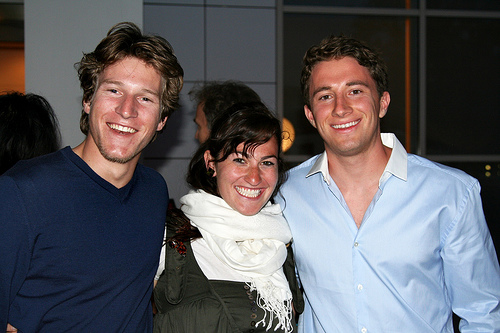 said, a camera lasts about 20 months. Other products are even more short-lived: the first-generation iPhone was replaced by the second within months. Still, Sudjic noted, six months is time enough to build a relationship: the device is multi-functional, pocket friendly, and has character as a physical object, even if its software is more important than anything else.
said, a camera lasts about 20 months. Other products are even more short-lived: the first-generation iPhone was replaced by the second within months. Still, Sudjic noted, six months is time enough to build a relationship: the device is multi-functional, pocket friendly, and has character as a physical object, even if its software is more important than anything else.
Still, Sudjic said, “Our relationship with an object doesn’t really have the time to mature as it once did.” Objects are no longer meant to hold on to, to pass down, to carry memories and age well. They are the worse for wear, in fact, as Sudjic discovered when he saw he “was leaving greasy fingerprints” all over his Macbook. As objects dematerialize, we keep consuming and overconsuming. But design still matters, even if it is overused and sometimes useless. As Sudjic said during Q&A, “We don’t have to have every chair be comfortable. Sometimes we are meant to look at them.”
Watch the video here.
See more photos here.
Buy the book here.
*Photos by Aaron Salcido.




Send A Letter To the Editors